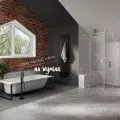Computer simulations are present in all engineering fields, allowing a model of real phenomena to be recreated in digital conditions. Aeronautics uses simulations in wind tunnels to check the strength and behavior of aircraft, physicists create advanced mathematical models to simulate the behavior of a black hole, while builders use simulations to check the strength of a designed structure. Thanks to the development of personal computers, previously extremely time-consuming calculations are now possible without access to supercomputers.
Also in the field of architecture, simulations have dawned as tools to compare alternatives in terms of their impact on users and the environment. By using three-dimensional models, it is possible to predict the impact of factors such as daylight, wind or noise on the functioning of future users of a space, both at the scale of a building and at the scale of a city.
daylight simulations
On average, humans spend more than 90 percent of their time in buildings - living, working, studying or shopping. During this time, he is exposed to the negative effects of space arrangement on his health involving disruption of the biological clock. Most often, the problem lies in the poor quality and quantity of light. A report published by the World Green Building Council shows that workers who are provided with access to natural light are 18 percent more productive and show greater comfort at work. That's why solar simulations are the broadest group of tools. It is possible to simulate both the effects of daylight and artificial light on user functioning. The simplest type of daylight-related simulations are sunlight simulations. By using the incidence vectors of natural light for a given day or period, it is possible to calculate, for example, the insolation specified in Polish legislation and to calculate the average insolation value for public spaces, which in turn makes it possible to make decisions on space development. The calculation of insolation using simulation allows a quick assessment of the fulfillment of conditions and eliminates possible errors resulting from the use of the sun ruler method.
There are also methods of assessing daylight in interiors that are only possible through the use of simulations, which calculate a model composed of geometry and the finishing materials used. In this group of simulations we can include Daylight Factor, Daylight Autonomy and Glare Analysis.
{The training and research center of the District Medical Chamber in Gdansk: Solar Glare Analysis,title=the training and research center of the District Medical Chamber in Gdansk: Solar Glare Analysis}
training and scientific center of the Regional Chamber of Physicians in Gdansk: Solar Glare analysis
© Designbotic
A popular assessment of lighting conditions in building interiors is the Daylight Factor, which determines the ratio of external daylight intensity to light entering a building. The Daylight Factor calculation uses a model of the sky, as opposed to sunshine hours, to help calculate near real-world environmental conditions. Daylight Factor is concerned with the visual comfort of users and is therefore calculated at the height of a working plane, such as a desk. Recent years have seen a significant development of simulations in areas aimed at improving the health and comfort of future users, which is why the Daylight Factor is included as an evaluation criterion in BREEAM building certification and the recently announced Green House certification by the Polish Green Building Association. Conducting simulations in the early stages of the concept and its further verification increases the chances of getting a high rating in the building certification process.
Another type of assessment of daylight in a building's interior is dynamic daylight simulations, which, unlike static ones (Daylight Factor), use data such as a year-round sky model built from weather station measurements, in addition to building geometry and finishing materials, and take into account the hours when rooms are in use. Due to their high measurement accuracy and complexity, dynamic simulations are becoming an increasingly popular method for assessing daylight-related conditions. In BREEAM, LEED and WELL certification, two methods are used to assess conditions: Spatial Daylight Autonomy (sDA) and Annual Sunlight Exposure (ASE). The first metric, sDA, indicates what proportion of a building's floor space meets a minimum of 50 percent of occupants' time in conditions that provide 300 lux of daylight. The ASE, on the other hand, like the previously described sDA, examines the intensity of light in a room, but allows prediction of the negative impact of light on the user. With the simulation and the ASE metric, we can indicate the percentage of surveyed room areas for which there is a light intensity above 1,000 lux for a minimum of 250 hours per year. With these two metrics and the use of dynamic simulations, we are able to both ensure the minimum level of light necessary for comfortable work and protect users from the negative effects associated with too much light intensity.



ASE simulation for comparing the quality of natural lighting for two types of facades
© Designbotic
Simulations that calculate sDA and ASE indices allow appropriate design decisions to be made to ensure the best comfort for users. It should be noted, however, that they are a simplification of sorts, not verifying which spaces will actually be used by users or how they will be positioned. Glare Analysis simulations allow the calculation of luminance, or the intensity of light falling directly toward the user's viewing angle. The calculations use both the relevant sky model, the geometry of the building, the arrangement of the room, the reflectance values of the materials and equipment used, and the exact location of the users' work. For each of the future users of the space, the possibility of glare - an undesirable state of the vision process that reduces the comfort of work and can cause ill health - is studied.
Tunnel simulations of wind and air mass movements
The most computationally advanced type of simulations in the architectural field are those related toComputational Fluid Dynamics(CFD). They serve engineers in particle flow analyses by simulating particle behavior in a digital environment. In the broad field of engineering, they are used to design turbines, engines and the geometry of aircraft and vehicles. The simulations are extremely sophisticated because they reproduce a complex environment, taking into account pressure, temperature, densities and particle flow, while in the field of architecture, they additionally require a large-scale model of the environment (estimated to be within 300 meters).



Simulation of wind impact on The Shard skyscraper in London
© Designbotic
The simulation is created separately for each wind direction, taking into account its speed for the location. Thanks to the results of the calculations, it is possible to study in a digital environment such aspects as the effect of wind on the building structure, the spread of pollutants or wind speed at pedestrian level.
Wind analysis is among the simulations that are performed least often due to its complexity and the lack of a requirement for calculations by national regulations or building certification. However, this situation may soon change. In 2011, a fatal tragedy occurred in the city of Leeds as a result of high wind speeds, which were further multiplied by the mass of the studwelve-meter Bridgewater Place building. The wind blowing at tremendous speed knocked a truck over onto a pedestrian - one of twenty-five accidents in the area resulting from the geometry and location of the building. In the wake of this accident, the Wind Microclimate Guidelines document was introduced in the UK in 2019, which provides information on how to prepare documentation on the impact of wind on pedestrians, required for hospitals and buildings over 25 meters high, among other things.



Wind Pedestrian Comfort analysis
© Designbotic
One method of predicting the impact of wind on pedestrians is the Wind Pedestrian Comfort simulation, which involves calculating the average wind speed for a given location and comparing it to the City Lawson Criteria, which defines speed as allowing sitting, occasional sitting, standing, walking or defines conditions as uncomfortable. The simulation can help make decisions about both building form, location of building entrances, landscaping and the routing of bike paths.
solar radiation analysis
In the field of construction, solar radiation analysis plays an important role in shaping form. The use of radiation simulation makes it possible to determine a building's solar energy resources, which allow savings in the maintenance of the building through passive energy gains. By using meteorological data for a given location and a three-dimensional model of the building and its immediate surroundings, it is possible to perform the relevant analyses. It should be noted that maximizing radiant energy gains can also lead to negative consequences, such as overheating of the building during the summer, which in turn results in energy expenditures for room air conditioning. The use of a series of simulations can help find the optimal spatial solution both at the scale of the building body and its facade, which, if properly designed, helps regulate temperature levels.



Solar Radiation simulation
© Designbotic
designbotic need to use simulation
Progressive climate change in the form of temperature changes, as well as extreme weather conditions, requires a response in the form of sustainable design. Buildings of the future will incorporate many green solutions to reduce environmental impact, increase their quality, lifespan and improve occupant comfort.
Achieving such a design outcome is only possible through the use of computer simulations in every design phase, starting with the concept.
Today's available tools allow designers to ensure the highest quality of office and residential spaces with the help of natural sunlight while introducing protection against excessive heat. In designed urban interiors, we can ensure the comfort of future users by modeling the massing of buildings and greenery to protect against wind, noise or dust.
In addition to the standard architectural simulations described above, it is possible to create research models designed for specific design problems. Such efforts are already being undertaken by major Western design firms (e.g. Foster + Partners, UNStudio or Bjarke Ingels Group). With the growing importance of certification systems and clients' awareness of healthy buildings, computer simulations will surely become a permanent fixture in architectural practice.
Kacper RADZISZEWSKI, Jakub BLADOWSKI
designbotic.pl
Illustrations: authors' archives



























